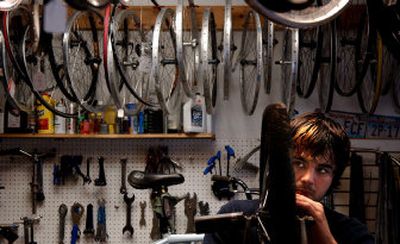Spring tuneup

Consider the bicycle.
For most of us, it afforded a chance to expand our neighborhood and indulge our imagination. It’s reliable transportation and able recreation.
And it requires a little regular consideration.
Most people put their bike away once the snow flies and don’t give it a second thought until the weather warms in the spring.
That’s unfortunate timing.
“Ideally, people would bring their bike in for a tune-up during the winter so it will be ready for them in the spring,” said Paul Edwards of Argonne Cycle, 3215 N. Argonne Road. “If you ride a lot, it’s a good idea to have it put up on a rack and checked over.”
Your local bike shop generally runs a spring tune-up special. A good bike mechanic can check your bike for signs of wear and perform routine maintenance.
Here’s a spring checklist.
1. Check your bike’s tire pressure. Sitting over the winter generally translates into a loss of air pressure.
“You also want to check the tires themselves for signs of wear,” Edwards said. “Follow your common sense. If you ride a lot, you probably want to replace your tires every year.”
2. Check and lube your tire chain.
“It’s a good idea to give the chain a thorough cleaning,” Edwards said. “A good solvent works. Kerosene works really well, since it’s really just a very thin oil and it leaves a thin layer of lubrication. That’s what competitive bike racers use.”
It’s a good idea to lubricate the chain regularly.
“If you ride a lot, it’s a good idea to lube your chain on every other ride,” Tyler Johnson of Wheel Sport Cycle and Fitness, 606 N. Sullivan Road. “We recommend a good Teflon-based spray. There’s another good one – a wax-based one that works really well – but you have to ask for it specifically.”
3. Check to make sure the chain and gear system aren’t worn and work properly.
“You don’t want to have slack in the system,” Edwards said. “If you get too much slack you get slippage and you can break off cogs. You want it to work properly.”
4. A bike’s cables should be checked for signs of rust or wear and lubricated.
“When I bring a bike in for a tune-up, I pull the cables and give them a thin coat of grease to make sure they work smoothly,” Edwards said.
5. Make certain your wheels are true – meaning your bike’s wheels are perfectly round. It involves adjusting the spokes.
“That’s one of the things that’s easier to do when you can put your bike up on a rack,” Johnson said.
6. Check your bike’s shift system. Make sure gear changes respond properly and the shifter doesn’t feel loose.
7. Check your bike’s bearings.
“The seals they’re using these days are getting better and better, but over time lubricants can break down,” Edwards explained. “It’s a good idea to check and a good idea to have the bearings repacked every couple of years.”
8. Make sure your bike meets state law.
“State law requires that a bike have a headlight and a rear reflector if you’re going to ride after dark,” Edwards said. “A tail light is a good idea, but it’s not required. Side reflectors are a good idea, too.”
9. Check your bike pump to make sure it’s in good working order. Over time they can wear our or dry out and stop working – not a good thing if you have a flat tire on the road.
10. Check your on-board repair kit.
“You want to carry a spare inner tube and things like that,” Edwards said. “You want to have a couple wheel wrenches in case you need to change a tire, and you can get a good multitool that will have everything else you need.”
It’s also a good idea to make sure your bike locks are in good working order, especially if you’re planning to leave your bike in a public place.
“Remember where you bought your bike,” Johnson said. “When you buy a bike from us, your first tune-up is always free, and we do brake and derailleur adjustments free for the life of the bike. Other bike shops have similar policies, so it’s worth checking out.”